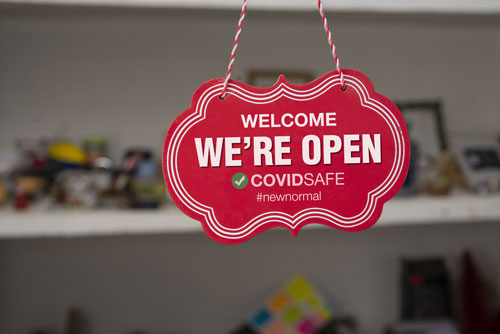The foodservice industry continues to struggle with restrictions, business and supply chain interruptions and with the COVID surge over the past weeks, we are potentially looking at new regulations. With uncertainty still swirling around, communication will continue to be a critical ingredient in surviving and thriving until we get back to “business as usual” heading into 2021. For service agents and operators, communicating with employees and customers should be front of mind. Below we’ve pulled together some recommendations on how to get the word out.

Strategies and tactics to help restaurants, and the service companies that serve them, share safety messages and exceed expectations.
Want a message to stick? Repeat it.
Not once.
Not in just one format.
Not just in one channel.
Repetition is important for recall and retention. As the foodservice industry navigates the COVID-19 pandemic and the road to recovery, restaurants and service agents want to reassure customers of their safe practices.
People are interested in hearing about safety measures that affect their touchpoints with the restaurant — food, employees, takeout/delivery (Datassential).
Consistent communication will show your commitment to safety and build lasting communities and brand loyalty.
Building communities
Who makes up your community?
- Employees
- Patrons – current and potential
- Fellow restaurants in area/franchisees
- Service agent network
- Vendors, suppliers and partners
- Local government and other leadership
Think about what is important to each group and how you can effectively reach them with messages that will resonate.
Communicating with your team
Let’s start with employees. Your team plays a critical role in implementing safety best practices. Keep them top of mind by using these internal communication tools.
- Emails
- Zoom calls
- Text messages
- Signage or posters in back-of-house, break rooms or office settings
- Daily shift meetings
- Recognition programs with incentives
Communicating externally
Leverage your existing communication methods — or develop new ones — to reach community members outside of your operation or business. These are key ways to reiterate safety messages and encourage business during the time of COVID.
- Social media
- Website
- Emails
- Advertising
- Text messages/SMS
- Signage outside and around restaurant
- Flyers or coupons with delivery/takeout orders
- Phone talking points or answering machine message
- Introduction of apps to minimize contact between servers and customers
Prioritizing sanitation
Using the internal communication tools, the most essential messages are around sanitation and how the employee should make it an even bigger priority. Share these important reminders:
- Employees should wash their hands frequently (e.g. before, during, and after preparing food; after touching garbage) with soap and water for at least 20 seconds
- If using a three-compartment sink to sanitize, check the time and temperature requirements for the sanitizer you are using and use a test kit to check concentration.
- Clean and disinfect frequently touched surfaces (e.g., door handles, cash registers, workstations, sink handles, bathroom stalls) at least daily, or as much as possible and as required by food safety requirements.
- Clean shared objects (e.g., payment terminals, tables, countertops/bars, receipt trays, condiment holders) between each use.
- Emphasize actions and exaggerate motions – you’re the ones ensuring guests see you do the things that they want to see to feel safe
- Make a public sanitizing promise explaining what employees will be doing and incorporate it into signage
- Put hand sanitizer, disposable disinfecting wipes and other supplies on tables or high-traffic areas
Real-world examples
There are paths of touchpoints where messaging can be shared with customers. Here are two examples:
Dine-in customers
- Customers see a restaurant’s post on social media, mentioning COVID-19 and the steps being taken
- They visit the restaurant’s website and read a message about safety procedures
- The customers call and confirm safety steps with hostess
- They arrive at the restaurant, and scan the QR code on the table to pull up their menus, use the hand sanitizer on table and see all employees wearing masks
- As they leave, they see employees thoroughly wiping down tables and chairs
Carryout customers
- Customers receive an email from a restaurant and decide to get takeout
- They park their car in designated pickup spot
- Their food is delivered by employee wearing mask, gloves and button that says “Committed to your safety”
- They receive their food sealed in a bag with a sticker that says “Prepared safely for you”
- When they open the bag at home, they see a flyer sharing the restaurant’s safety procedures and offering them 10% for dining in
What about service agents?
Technicians that service commercial kitchens contribute to that operation’s safety culture by following procedures. You can also communicate the steps you are taking to keep everyone safe.
Steps to consider
- Separate PPE, gloves or even coveralls at each job
- Wipe down tools on site before use and equipment before leaving
- Offer essential products like ice machine sanitizer, cashier shields, sanitizer stations and handwashing timers for staff
Additional places to incorporate safety messages
- Appointment confirmation
- Pre-arrival email or text that outlines the technician’s procedures
- Service invoices
- Leave-behind service flyers
At the end of the day, we are all stronger together ― manufacturers, dealers, distributors, restaurant owner/operators and service agents. We know it will take all of us to navigate the future of foodservice.
Join the discussion ― follow us on social media, visit our blog and subscribe to the PartsCast podcast via Apple Podcasts, Spotify or your podcast player of choice.
Sources:
https://www.cdc.gov/coronavirus/2019-ncov/community/organizations/business-employers/bars-restaurants.html
https://www.servsafe.com/ServSafe/media/ServSafe/Documents/Clean-and-Sanitize-in-a-Three-Compartment-Sink.pdf
https://datassential.com/wp-content/uploads/2020/06/Datassential-ONE-TABLE-Consumer-Report-F.pdf
Content sponsored by Parts Town & Heritage Parts.



